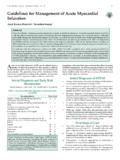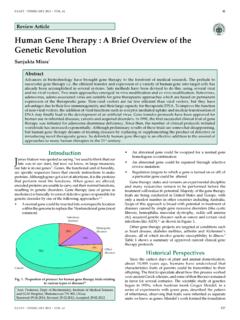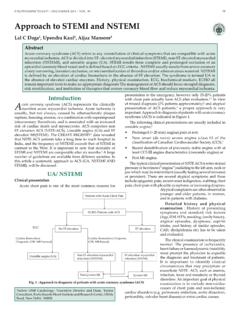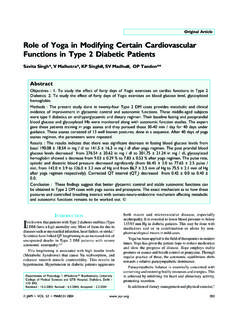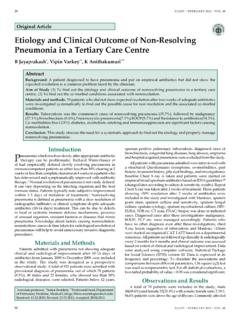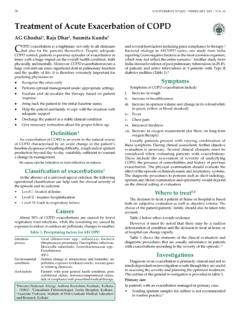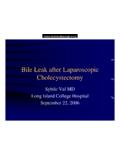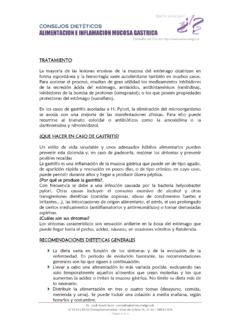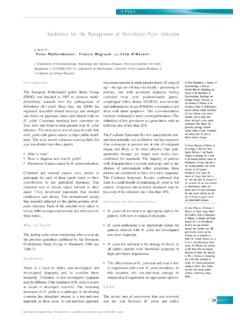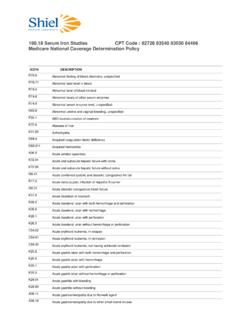Transcription of Emphysematous Gastritis with Air in Portal Venous …
1 Journal of The Association of Physicians of India Vol. 65 May 2017104 Emphysematous Gastritis with Air in Portal Venous SystemOmesh Goyal1, Ajesh Bansal2, Prerna Goyal3 AbstractEmphysematous Gastritis is a rare but severe form of phlegmonous Gastritis caused by gastric mucosal disruption and infection of stomach wall by gas-forming bacteria. Ingestion of corrosive substances is the most common predisposing factor, followed by alcohol abuse, abdominal surgery, diabetes and immunosuppression. Patients usually present with abdominal pain, vomiting, diarrhea, constipation and/or gastro-intestinal hemorrhage.
2 Characteristic radiological findings include presence of gas in the gastric wall. Management of this condition includes broad-spectrum antibiotics and supportive therapy. Outcome of Emphysematous Gastritis is frequently fatal due to septic shock and multi-organ failure. We report a case of a 65 years old male who presented with fever and upper abdominal tenderness. He had history of uncontrolled diabetes and chronic alcohol intake. Radiological investigations revealed air within the gastric wall, Portal vein, liver and spleen.
3 Despite initial improvement with conservative management, patient succumbed due to sepsis and Professor, 2 Senior Resident, Department of Gastroenterology, 3 Former Consultant, Department of Medicine, Dayanand Medical College & Hospital, Ludhiana, PunjabReceived: ; Revised: ; Accepted: Gastritis (EG) is a rare disease characterized by the presence of gas in the gastric wall. Common predisposing factors include ingestion of corrosive substances, alcohol abuse, abdominal surgery, diabetes and Common presenting symptoms include abdominal pain, vomiting, diarrhea/constipation and gastro-intestinal hemorrhage.
4 Management with broad-spectrum antibiotics remains the mainstay of initial therapy. We report a case of a 65 years old male having uncontrolled diabetes and history of chronic alcohol intake who presented with fever and upper abdominal tenderness and was diagnosed to have EG. Case ReportA 65 years old male presented with history of high grade fever since 2 days. He had been suffering from type 2 diabetes mellitus since 3 years (recently uncontrolled). There was history of significant amount (> 100 gm/day) of alcohol intake almost daily since last 20 years until recently.
5 There was no h/o pain abdomen, gastro-intestinal bleed, or jaundice. There was no h/o corrosive ingestion, recent gastroenteritis or abdominal surgery. Examination revealed abdominal distension, epigastric tenderness and decreased bowel sounds. His blood pressure was 100/70 mm Hg, pulse rate-100/min, respiratory rate-18/min and F. Investigations revealed: g/dl, Total leucocyte x103/mm3, platelets- 80,000/mm3, urea-100 mg/dl, creatinine- mg/dl, Aspartate Transaminase-758 IU/ml, Alanine Transaminase-275 IU/ml. Amylase/lipase were within normal limits.
6 Abdominal ultrasonography was normal except multiple echogenic foci with dirty acoustic shadowing in both lobes of liver s/o air in Portal vein (PV) radicals. CT abdomen revealed specks of air in dependant part of stomach wall, along with thickening of proximal duodenum with air in its wall (Figure 1). Specks of air were also seen in PV, Superior mesenteric vein (SMV) and liver parenchyma (likely to be in PV radicals). During the hospital stay, patient developed upper gastro-intestinal (UGI) bleed. UGI endoscopy revealed large superficial ulcers in distal gastric body and antrum.
7 Patient was managed conservatively with broad spectrum antibiotics and other conservative measures. Despite initial improvement, patient succumbed within one week due to overwhelming sepsis and is an extremely rare form of acute phlegmonous Gastritis caused by a diffuse infection of stomach wall by gas-forming bacteria. The differential diagnosis includes gastric emphysema occurring due to invasion of gas (barotrauma) into gastric wall, as a result of acute occlusion of gastric emptying or complications following endoscopic first review on EG by Moosvi et al1 included 27 cases derived from the literature from 1889 until 1990.
8 Another review by Tsuan-Hao et al4 described 15 cases from 1990 to 2005. A further of about 10 case reports have Fig. 1: Computed tomography of abdomen revealing air specks (a) in the dependant part of stomach, spleen and hepatic parenchyma; and (b) in stomach and Portal vein (a) (b)Journal of The Association of Physicians of India Vol. 65 May 2017105been published in world literature since then, while none has been reported from physiological conditions, stomach wall is well protected from bacterial infection by the close connection between cells, an acid pH and good blood supply.
9 Factors damaging these protective mechanisms leading to EG are- ingestion of corrosives (37%), overindulgence in alcohol (21%) and abdominal surgery/gastroenteritis in about 15% In addition, diabetics may be prone to develop EG due to intestinal circulatory disturbances due to diabetic microangiopathy and predisposition to microbial infection due to Rheumatic diseases, treatment with corticosteroids/cytotoxins, and peritoneal dialysis are other predisposing Altered gastric mucosa due to various insults is invaded by gas-forming bacteria.
10 Possibly due to local spread of infection or hematogenous dissemination from a remote focus such as otitis. Most frequently isolated microorganisms are streptococci, enterobacteriaceae, Escherichia coli, Pseudomonas aeruginosa, Clostridium perfringens and Staphylococcus aureus; rarely, Klebsiella pneumoniae, Candida albicans, Proteus sp., Bacteroides sp., Bacillus subtilis and other In our patient, diabetes mellitus and heavy amount of alcohol ingestion were the factors probably compromising protective function of stomach wall leading to , clinical presentation is dramatic.
